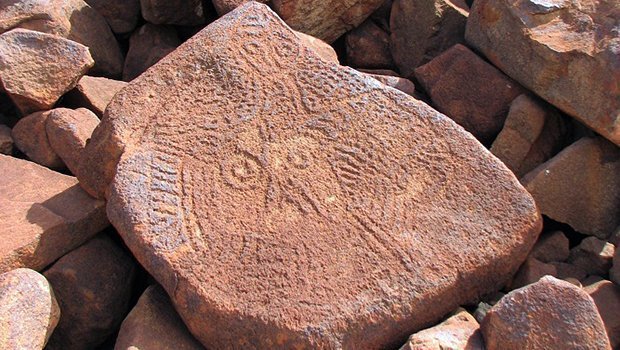Burrup Peninsula rock art among world’s oldest

RESEARCH INTO THE rate of erosion of Pilbara rocks has put an upper limit on the possible age of up to a million ancient Aboriginal engravings in the Burrup Peninsula of Western Australia.
The peninsula and surrounding Dampier Archipelago have the highest concentration of rock art in the world. The carvings, called petroglyphs, include depictions of human-like figures, human faces and animals that no longer inhabited the region, including the Tasmanian tiger.
Archaeologists haven’t been able to date engravings directly, but have previously estimated some of them to be up to 30,000 years old based on the style of the art and weathering patterns. One group of petroglyphs showing land-based animals, is thought to date from a time during the last ice age, when sea levels were lower and the area was far inland.
Low rates of erosion
The new study, led by Professor Brad Pillans, a geologist at the Australian National University, shows that rocks here have some of the lowest recorded rates of erosion in the world.
“The combination of hard rock and low rainfall means low erosion, so we have the potential for preserving rock art for much longer periods of time than in many other places,” he told Australian Geographic.
The study published last week in the journal Quaternary Science Reviews shows that the deepest engravings could theoretically survive on these rock surfaces for up to 60,000 years, although the researchers do not claim they are this old.
Cosmic radiation used to date rocks
Brad and his co-author Professor L. Keith Fifield came to that conclusion by measuring levels of Berylllium 10. This is a radioactive isotope that accumulates in the surfaces of rocks because of radiation from space and indicates how long they have been exposed to the elements.
These findings support the idea that some of the rock art predates the last ice age, which occurred around 22,000 years ago, says Dr Ken Mulvaney, an archaeologist with Rio Tinto who produced the most recent age estimates based on the style of the art and weathering patterns.
The erosion “is such a slow process that the petroglyphs could remain visible for 60,000 years,” says Ken, who adds that neither he nor Brad think the rock art actually is that old. Based on current evidence people only arrived in this part of Australia sometime between 35,000 and 42,000 years ago, he says.
Wonder of Aboriginal Australian heritage
Commenting on the findings, Professor Paul Tacon, a rock art specialist at Griffith University on the Gold Coast in Queensland, said the finding was an interesting one, but agrees that it doesn’t bring researchers any closer to working out an age for the Burrup rock art.
“It opens up the possibility that some of this rock art is tens of thousands of years of age. But a lot of other different forms of research need to be done to see how old some of the oldest art is,” he says.
Brad adds that the petroglyphs are a wonder of Aboriginal Australian heritage.
“When I first visited the Burrup Peninsula, I was absolutely amazed by the sheer number and variety of Aboriginal rock art engravings,” he says. “It’s estimated that there are up to one million images there, many of which are spectacular works of art. Given the extraordinary amount and diversity of the rock art and its potential antiquity, I rather hope the area will soon be nominated for World Heritage listing.”
RELATED STORIES

